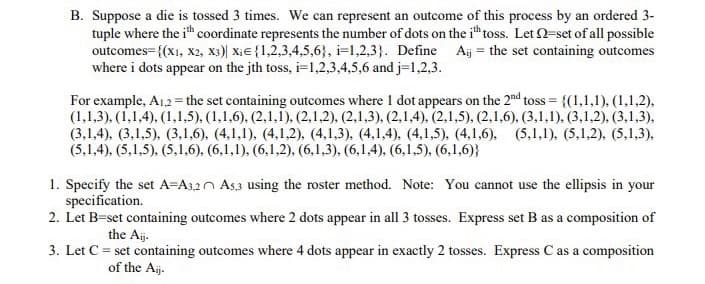B. Suppose a die is tossed 3 times. We can represent an outcome of this process by an ordered 3- tuple where the ith coordinate represents the number of dots on the ih toss. Let 2-set of all possible outcomes={(X1, X2, X3) X₁E {1,2,3,4,5,6), i=1,2,3). Define Aij = the set containing outcomes where i dots appear on the jth toss, i=1,2,3,4,5,6 and j=1,2,3. For example, A1,2 = the set containing outcomes where 1 dot appears on the 2nd toss = {(1,1,1), (1,1,2), (1,1,3), (1,1,4), (1,1,5), (1,1,6), (2,1,1), (2,1,2), (2,1,3), (2,1,4), (2,1,5), (2,1,6), (3,1,1), (3,1,2), (3,1,3), (3,1,4), (3,1,5), (3,1,6), (4,1,1), (4,1,2), (4,1,3), (4,1,4), (4,1,5), (4,1,6), (5,1,1), (5,1,2), (5,1,3), (5,1,4), (5,1,5), (5,1,6), (6,1,1), (6,1,2), (6,1,3), (6,1,4), (6,1,5), (6,1,6)} 1. Specify the set A-A3,2 A5,3 using the roster method. Note: You cannot use the ellipsis in your specification. 2. Let B-set containing outcomes where 2 dots appear in all 3 tosses. Express set B as a composition of the Aij. 3. Let C = set containing outcomes where 4 dots appear in exactly 2 tosses. Express C as a composition of the Aij.
B. Suppose a die is tossed 3 times. We can represent an outcome of this process by an ordered 3- tuple where the ith coordinate represents the number of dots on the ih toss. Let 2-set of all possible outcomes={(X1, X2, X3) X₁E {1,2,3,4,5,6), i=1,2,3). Define Aij = the set containing outcomes where i dots appear on the jth toss, i=1,2,3,4,5,6 and j=1,2,3. For example, A1,2 = the set containing outcomes where 1 dot appears on the 2nd toss = {(1,1,1), (1,1,2), (1,1,3), (1,1,4), (1,1,5), (1,1,6), (2,1,1), (2,1,2), (2,1,3), (2,1,4), (2,1,5), (2,1,6), (3,1,1), (3,1,2), (3,1,3), (3,1,4), (3,1,5), (3,1,6), (4,1,1), (4,1,2), (4,1,3), (4,1,4), (4,1,5), (4,1,6), (5,1,1), (5,1,2), (5,1,3), (5,1,4), (5,1,5), (5,1,6), (6,1,1), (6,1,2), (6,1,3), (6,1,4), (6,1,5), (6,1,6)} 1. Specify the set A-A3,2 A5,3 using the roster method. Note: You cannot use the ellipsis in your specification. 2. Let B-set containing outcomes where 2 dots appear in all 3 tosses. Express set B as a composition of the Aij. 3. Let C = set containing outcomes where 4 dots appear in exactly 2 tosses. Express C as a composition of the Aij.
Chapter8: Sequences, Series,and Probability
Section8.6: Counting Principles
Problem 74E: Lottery Powerball is a lottery game that is operated by the Multi-State Lottery Association and is...
Related questions
Question
B. 2 Only

Transcribed Image Text:B. Suppose a die is tossed 3 times. We can represent an outcome of this process by an ordered 3-
tuple where the ith coordinate represents the number of dots on the ih toss. Let 2-set of all possible
outcomes={(X1, X2, X3) XiE {1,2,3,4,5,6), i=1,2,3). Define Aij = the set containing outcomes
where i dots appear on the jth toss, i=1,2,3,4,5,6 and j=1,2,3.
For example, A1,2 = the set containing outcomes where 1 dot appears on the 2nd toss = {(1,1,1), (1,1,2),
(1,1,3), (1,1,4), (1,1,5), (1,1,6), (2,1,1), (2,1,2), (2,1,3), (2,1,4), (2,1,5), (2,1,6), (3,1,1), (3,1,2), (3,1,3),
(3,1,4), (3,1,5), (3,1,6), (4,1,1), (4,1,2), (4,1,3), (4,1,4), (4,1,5), (4,1,6), (5,1,1), (5,1,2), (5,1,3),
(5,1,4), (5,1,5), (5,1,6), (6,1,1), (6,1,2), (6,1,3), (6,1,4), (6,1,5), (6,1,6)}
1. Specify the set A=A3,2 A5,3 using the roster method. Note: You cannot use the ellipsis in your
specification.
2. Let B=set containing outcomes where 2 dots appear in all 3 tosses. Express set B as a composition of
the Aij.
3. Let C = set containing outcomes where 4 dots appear in exactly 2 tosses. Express C as a composition
of the Aij.
Expert Solution
This question has been solved!
Explore an expertly crafted, step-by-step solution for a thorough understanding of key concepts.
Step by step
Solved in 2 steps with 2 images

Recommended textbooks for you


Algebra and Trigonometry (MindTap Course List)
Algebra
ISBN:
9781305071742
Author:
James Stewart, Lothar Redlin, Saleem Watson
Publisher:
Cengage Learning


Algebra and Trigonometry (MindTap Course List)
Algebra
ISBN:
9781305071742
Author:
James Stewart, Lothar Redlin, Saleem Watson
Publisher:
Cengage Learning